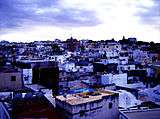Tanger-Med
Tanger-Med is a cargo port located about 40 km east of Tangier, Morocco. It is one of the largest ports on the Mediterranean and in Africa by capacity and went into service in July 2007.[1] Its initial capacity was 3.5 million shipping containers.[2]
Overview
The Tangier-Med Project will contain the biggest port in Africa. The project is a strategic priority of the Moroccan government for the economic and social development of the North Morocco region. It is part of the economic policy orienting Morocco towards exports, based on eight clearly identified export sectors, with particular emphasis on the free trade agreement with the European Union to be implemented by 2012.

Completion of the «Tangier-Mediterranean» project will have important economic effects in terms of jobs, creation of added value and foreign investment. Its particular position on the Straits of Gibraltar, at the crossing of two major maritime routes, and 15 km from the European Union will enable it to serve a market of hundreds of millions of consumers through the industrial and commercial free zones which will be run by well-known private operators. It will also win part of the strong growth market of container transshipment and become the leading hub for cereal transshipment, a facility which is non-existent in the north-west African region at present.
The project will be implemented, coordinated and managed by TMSA, a private company with public prerogatives, operating under an agreement with the State and interacting with the different ministries involved.
The port complex will have important economic effects in terms of jobs, creation of added value and foreign investment. In addition to the economic effects of the operation of the port, there will be important effects resulting from its construction, particularly through foreign investments, and others from the operation of the free zones (direct and indirect added value, direct gains, jobs and foreign investment).
A draft loan contract of $180 mln to fund the expansion works of Tanger-Med port was signed in October 2008 to for building a second deepwater port, dubbed "Tangier Med II", to meet the growing demand for containers treatment at the international level in sea transport. The new port facilities, scheduled to be operational by the second half of 2012, will include two new container terminals with a total length of 2,800 m and an additional nominal capacity of 5 million containers.[3] Final official approval for "Tangier Med II" was received on 7 January 2009, with actual construction started on 17 June 2009.[4][5] In November 2010 the European Investment Bank (EIB) signed a loan of €200 million for the extension of the port.[6]
The port is expected to reach full capacity by 2015, and to operate 8 million containers, 7 million passengers, 700,000 trucks, 2 million vehicles, and 10 million MT of oil products.[7] When completed in 2018, it is expected to be the busiest port on the Mediterranean.[8]
Capacité du Port
Port Tanger Med I
3 millions de conteneurs de capacité 1,6 km de quais à conteneurs à – 16 et -18 mètres 2,6 Km de digues 140 hectares de terre – pleins dont 80 hectares pour le trafic conteneur, desservis par voie ferrée 2 postes pétroliers 0,6 km de quai vraquier
Port Tanger Med Passagers
2,5 km de digues 8 postes à quai avec des tirants d’eau de 9 et 12 mètres 35 hectares de terre-pleins entièrement dédiés à l’activité passagers et TIR Plusieurs espaces supports représentant un total de 30 hectares de terre – pleins
Port Tanger Med II
5,2 millions de conteneurs de capacité 2,8 km de quais à conteneurs à – 16 et – 18 mètres 4,8 Km de digues 160 hectares de terre -pleins entièrement gagnés sur la mer 2 postes pétroliers en option
See also
- List of deep water ports
- Tangier
- Economy of Tangier
- Port of Algeciras
References
- ↑ [http://www.tmpa.ma Tanger Med Port Authority
- ↑ "Tangier-Med port to be operational in July" Magharebia
- ↑ "AFESD approves loan", Maghreb Arabe Presse, deadlink 18 June 2009
- ↑ Staff (7 January 2009) "King launches construction works of Tanger-Med industrial park" Maghreb Arabe Presse
- ↑ Staff (18 June 2009) "Tanger Med expansion: King launches construction works" Morocco Business News
- ↑ "EIB signs €420 million in loans for Moroccan highways and port" ENPI Info Centre
- ↑ "Import-export activities kick off in Tanger-Med port, TMSA" Maghreb Arabe Presse, deadlink 18 June 2009
- ↑ "Morocco is doing well, but its king still needs to adapt". The Economist. 11 June 2016. Retrieved 11 June 2016.
External links
| Wikimedia Commons has media related to Tanger Med. |
Coordinates: 35°53′24″N 5°30′04″W / 35.890°N 5.501°W
